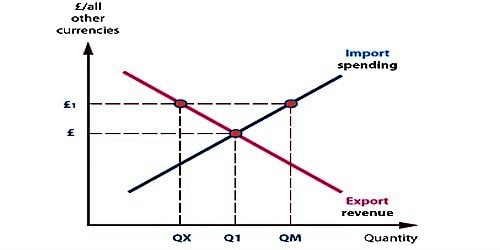Flexible or Floating Exchange Rate System
The system of the exchange rate in which the rate of exchange is determined by forces of demand and supply of foreign exchange market is called Flexible Exchange Rate System. Here, the value of a currency is allowed to fluctuate or adjust freely according to change in demand and supply of foreign exchange. A floating exchange rate is an administration where the exchange price of a country is set by the forex market based on supply and demand relative to other currencies. So, it refers to changes in a currency’s value relative to another currency (or currencies).
A flexible exchange rate is a rate which, like the price of a commodity, is determined by forces of demand and supply in the foreign exchange market. It changes according to a change in demand and supply of foreign currency. There is no government intervention. There is no official intervention in the foreign exchange market. Under this system, the central bank, without intervention, allows the exchange rate to adjust so as to equate the supply and demand for foreign currency. In India, it is a flexible exchange rate which is being determined. The foreign exchange market is busy at all times by changes in the exchange rate.
Advantages and disadvantages of this system are listed below:
Merits:
- Automatic Stabilization: Any disequilibrium in the equilibrium of payments would be involuntarily corrected by a change in the exchange rate.
- Freeing Internal Policy: Under the floating exchange rate method, the balance of payments shortage of a country can be rectified by changing the peripheral price of the currency.
- An absence of Crisis: The periods of fixed exchange rates were regularly characterized by predicament as too much force was put on the central bank to devalue or revalue the country’s currency.
- Deficit or surplus in BOP is automatically corrected and it frees the government from a problem of the BOP.
- There is no need for the government to hold any foreign exchange reserve,
- It helps in optimum resource allocation,
Demerits:
- Uncertainty: The very truth that currencies change in value from day to day introduces a huge element of ambiguity into the trade. The uncertainty introduced by floating exchange rates might deject direct foreign investment (i.e., investment by multinational companies).
- Speculation: The day-to-day fluctuations in exchange rates might encourage speculative movements of ‘hot money’ from country to country, thereby cause more and mooring exchange rate fluctuations.
- Lack of Discipline: The need to preserve an exchange rate imposes a regulation upon the national economy.
- Lack of investment – The uncertainty can lead to a lack of investment internally as well as from abroad.
- Speculation – Speculation will tend to be an intrinsic part of a floating system and it can be harmful and destabilizing for the economy, as the approximate flows may often differ from the underlying guide of trade flows. It encourages speculation leading to fluctuations in foreign exchange rate,
- Inflation – The floating exchange rate can be inflationary. It generates inflationary pressure when prices of imports go up due to the depreciation of the currency.
- Wide fluctuation in exchange rate hampers foreign trade and capital movement between countries.
Managed Floating:
This refers to a system of gradual adjustments in the exchange rate deliberately made by a central bank to influence the value of its own currency in relation to other currencies. This is done to save its own currency from short-term volatility in exchange rate caused by economic shocks and speculation. Thus, the central bank intervenes to smoothen out ups and downs in the exchange rate of home currency to its own advantage.
When central bank manipulates the floating exchange rate to the disadvantage of other countries, it is termed as dirty floating. However, central banks have no fixed times for intervention but have a set of rules and guidelines for this purpose.













